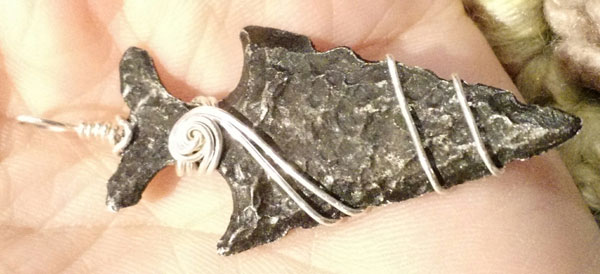Recent Posts
- Home
- Musings From the Store
- All Wrapped Up
All Wrapped Up
Posted by on

I am often asked by customers which tools and wire are best for wire wrapping. The answer is not very simple as it all depends on the size of the object you are wrapping, your preference of certain metals or colours over others and of course, your budget.
To beginners who are unsure if they will like this hobby enough to pursue it further, I recommend certain tools that are necessary to start with and possible types of wire to use. Of course, once you develop your style of wire wrapping you will find that you prefer using certain tools and types of wire over others.
Flush cutters are the number one tool necessary for wire wrapping. They allow you to produce straight edges on your wire that you can easily sand down or round off with a Wire Rounder tool to get rid of the sharp edges and prevent injury.
Chain nose and flat nose pliers will allow you to make precision bends and loops. You can start off with the chain nose pliers only as you are learning new wire wrapping techniques, but you will eventually find the flat nose pliers very useful for certain wire bending methods.
The round nose pliers will allow you to make perfect loops and rings with your wire. You may think they are not a necessity at first, but once you use them you will find they are very helpful in making loops and bails for your wire wrapped pendants.
While working with wire, you will find that it often seems to have a mind of its own, bending and kinking in not-so-optimal shapes. Another very useful tool for beginners and advanced wire wrappers alike is the wire straightening nylon jaw pliers that enable you to straighten your wire without scratching it.
Bent nose and needle nose pliers are not necessary for beginners. However, once you advance in your wire wrapping skills you will find these very useful. They allow you to get into very tight corners and make small precision bends.
One very common mistake beginner wire wrappers make is using serrated or ribbed jaw pliers commonly found at hardware stores. Stay away from these pliers! They will scratch your wire and result in nothing but frustration.

In order to get rid of unwanted scratches, however, a jeweller’s file or even fine sand paper can be used with non-plated base metal such as copper and brass wire, as well as precious metal such as silver wire. I do not recommend using this method with plated or coloured wire as sanding or filing it down will also remove the plating along with the scratches!
Wire comes in a variety of metals, colours, diameters and shapes. The wire gauges, or diameters, I recommend starting with are 20 or 22 gauge, depending on the size of the object you are wrapping. I prefer using 22 gauge as it is finer and therefore easier to maneuver. Using round wire instead of square or half round wire is also often preferred as it doesn’t twist and kink as much as square or half round wire. Regular softness wire is also easier to work than the harder, half-hard wire.
The metal you choose to use will depend on your personal preference. To beginner wire wrappers, I recommend starting with base metal wire such as copper, aluminum or the copper-based Craft Wire which comes in a variety of colours. As your first few tries are bound to be imperfect and possibly result in some frustration, you may end up throwing away some of the wire. Using base metal wire will not be very hard on your wallet while you are learning to wire wrap.
Once you feel confident enough you can move on to using precious metals such as sterling silver, gold or the more commonly used gold-filled wire which is more expensive than base metal wire. You will find that sterling silver wire, the preference of many wire wrappers, is much easier to work with than base metal wire. It is usually softer and easier to maneuver. You can also experiment with heavier wire gauges such as 18 or 16 gauge or finer wire gauges such as 24 or 26 gauge. Working with square or half-round wire allows you to create a different look to your wire wrapped work and I definitely recommend experimenting with them.
Taking a class or reading a book on wire wrapping basics before attempting to try wire wrapping is always a good idea and may reduce potential frustration. However, if you prefer to learn on your own, plenty of tutorials on wire wrapping are available on the internet.
 Loading... Please wait...
Loading... Please wait...
